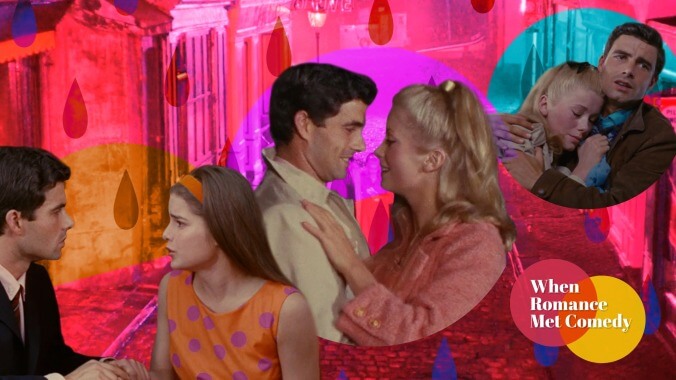The Umbrellas Of Cherbourg is timeless proof that musicals can be enchanting and deep
Image: Graphic: Libby McGuire
A swell of violins underscores a ballet of pastel umbrellas on a rainy cobblestone street. A burst of brass punctuates the tracking shot into a fire-engine-red mechanic shop. Like the overture of a stage musical, the opening moments of The Umbrellas Of Cherbourg ease viewers into the heightened world they’ll be visiting. Then comes the big buy-in moment: A young mechanic and a well-heeled customer discuss his car, only they sing their lines instead of speaking them. “Is it ready?” / “Yes. The engine still knocks when it’s cold, but that’s normal.” Hardly the stuff of poetry. But that’s the point. Every line of The Umbrellas Of Cherbourg is sung, from passionate declarations of love to exchanges about motor oil. It’s a big enough swing that the movie winkingly lampshades it early on. “I don’t like opera,” one character complains. “All that singing gives me a pain. I like movies better.”
Though Jacques Demy’s innovative 1964 movie musical was rapturously received when it debuted in France as Les Parapluies De Cherbourg, it also became something of a running joke. Parisians would sing “pass the salt” to mock the movie’s unusual sung-through format. When a skeptical French TV interviewer asked Demy why he had his characters sing their restaurant orders when people don’t do that in real life, Demy simply replied, “Why not? It would make life more pleasant!”
There’s no question that pure visceral pleasure is part of the aim of The Umbrellas Of Cherbourg. Demy once called the film “a singing Matisse.” Its vibrant costume and production design work in tandem to make the film feel like a candy store brought to life. Demy shot on location in Cherbourg but had his production designer, Bernard Evein, repaint the buildings in the French port city to evoke the glorious sets of a 1950s Hollywood musical. For his young lovers, Guy and Geneviève, Demy cast 27-year-old Italian actor Nino Castelnuovo and 20-year-old French newcomer Catherine Deneuve, respectively—two of the most beautiful performers to ever be paired together on screen. Deneuve, in particular, glows from her first shot to her last.
If you’ve only seen photos or clips of The Umbrellas Of Cherbourg, it would be easy to assume it’s a frothy, bubbly movie musical steeped in the buoyant spirit of the early 1960s. Yet the magic act of the film is that while it often looks, feels, and sounds like a romantic comedy, it’s actually a romantic drama. Demy explicitly set out to make a movie that would make people cry. And using the musical genre to evoke the tender, bittersweet feelings of first love seemed like a no-brainer. “I think singing is a natural mode of expression,” Demy explained in that TV interview. While his French New Wave peers often strove for realism in their grounded filmmaking techniques, Demy understood that heightened worlds often evoke the most realistic emotions.
That’s the secret of the musical genre, one its detractors miss when they dismiss musical theater as pure escapist hokum. It’s why I always slightly bristle when Singin’ In The Rain is held up as the greatest movie musical of all time. The gloriously staged but ultimately pretty emotionally simplistic Gene Kelly movie only captures a fraction of the range of musicals as an art form. For me, the emotional depth of 1961’s West Side Story is a much stronger encapsulation of the power of musical theater—a power that’s been around since Richard Rodgers and Oscar Hammerstein II helped pioneer the modern book musical in tuneful but complex shows like Oklahoma! and The King And I. West Side Story composers Leonard Bernstein and Stephen Sondheim took those building blocks even further. And while the thrill of color and dance are on display in West Side Story’s big screen adaptation, so is the musical genre’s ability to deliver social commentary and deeply personal relationships.
Although The Umbrellas Of Cherbourg looks like Singin’ In The Rain, it feels more like West Side Story, albeit in a much more intimate, small-scale way. There are no dance numbers in Umbrellas, but it deals in themes of class, war, gender, and personal compromise, while throwing in decidedly un-Hollywood plot points like a young woman who becomes pregnant out of wedlock and a man who visits a sex worker for comfort. Demy and his composer/collaborator Michel Legrand had a hard time selling The Umbrellas Of Cherbourg because they were in many ways pioneering a musical format that wouldn’t become popular onstage until later in the decade: stripped-down, sung-through concept musicals about everyday people’s lives, the sort of thing Sondheim perfected in his 1970 masterpiece Company, the story of a single man trying to figure out why he can’t commit to a relationship. Like Company, Umbrellas asserts that the small dramas of regular life are worthy of heightened interpretation—indeed, that they often feel that way when you’re experiencing them. So even though producers kept telling Demy that his simple, wistful love story would work better as a black-and-white character drama like his first two films, Lola and Bay Of Angels, he insisted The Umbrellas Of Cherbourg had to be a colorful movie musical.
